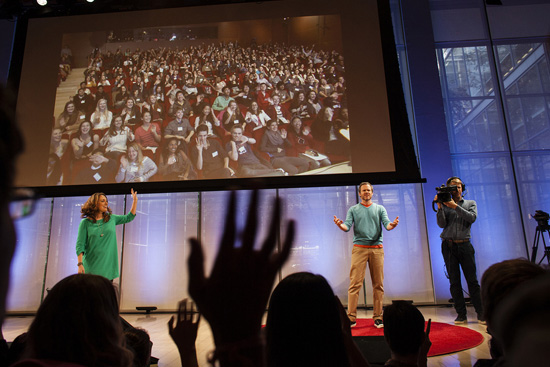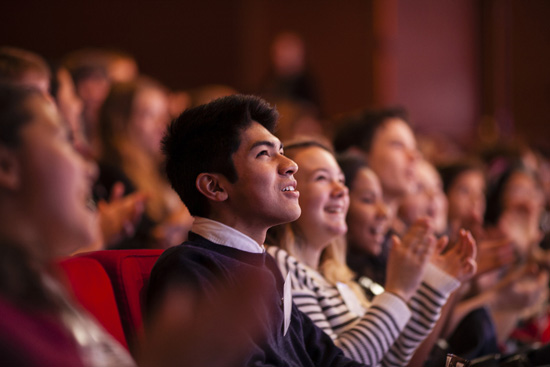 TEDYouth session two has just finished. You can read about each of the 12 speakers below, and also see summaries of the Session 1 speakers here.
TEDYouth session two has just finished. You can read about each of the 12 speakers below, and also see summaries of the Session 1 speakers here.
- Olivier Guyon, Optical Physicist and Astronomer
Olivier designs powerful telescopes that search for exoplanets — earth-like planets that exist outside of our solar system. The problem with search for them, he says, is that the numbers are astronomical. “If you count all the stars in our galaxy it would take more than a thousand years.” Fortunately, he and others are designing more powerful telescopes to search for such planets. For more see this TED-Ed lesson on how to find habitable planets.
. - Bobak Ferdowsi, Flight Director for the Mars Curiosity Rover mission
Not only did Bobak help land the Curiosity Rover on Mars, he became an Internet meme for his mohawk haircut. He reviews the extraordinary technology and techniques they used to land an SUV sized rover — overcoming such obstacles as the chance that the thrusters used on landing would blow a hole in the planet that the rover could never climb out of. (Watch NASA’s video on the “7 minutes of terror,” the time it took the rover to land.)
. - Lily He, one of the students in the audience, is also a master speed stacker. She shows off her cup-stacking skills, and then explains how it’s done.
. - Gaurav Tekriwal, Vedic Mathematician
Gauray teaches Vedic Mathematics, a super fast and fun way of solving large equations. He starts with a technique for multiplying by 11, eliciting wows over the simplicity. He moves on to something, harder: 98 x 97 = 9,506 almost instantly. A bit more advanced: leading the audience in a way to square large numbers in less than five seconds. “Woud you like maths to be dull and boring, or fun and interesting? The choice is yours.” (You can see him in action at TED@Bangalore as part of TED’s Talent Search.).
. - Dee Breger, Photomicrographer
Dee takes photographs that provide an intimate glimpse of the surprising microscopic structures of both familiar objects and exotic research samples. The audience is treated to an extraordinary slide-show of images, from a human hair to heart muscle to a lung with pneumonia. A photo of asbestos shows a dazzling arrangement of long, fibrous minerals — not good to breath. You can see those and more at her website.
. - Clifford Johnson, Physicist
Clifford is a theoretical physicist attempting to find the answers to questions like: Why are we here? Where did we and the world come from? And what is the world made of? Questions that get to how the universe works on the most fundamental level. Just like you can find out how a phone works by taking it apart, and finding smaller electronic components, physicists take matter apart, finding the smaller and smaller particles that make up the stuff around us. We’ve only scratched the surface though, and Clifford and other physicists are working on many open questions: There are patterns to particles, where do they come from? We’ve found there is a huge amount of dark matter — what is it? How does gravity work at the smallest level?
- Kelly Benoit-Bird, Marine Biologist
Kelly uses sophisticated sound technology to explore how animals in the ocean find their food while trying to avoid being someone else’s dinner. It turns out that there is very little food in the ocean — in the 400 seat TEDYouth auditorium there would be the equivalent of one tub of movie popcorn. But it’s even more complicated than that — animals do best when food is clumped, so regions with large amounts of food for seals, say, might not support large populations if the food is spread out instead of clumping. Using advanced sonar, she’s found remarkable patterns in the way animals find their food. (Watch also: This TED-Ed lesson on the secret life of plankton.)
. - Deborah Blum, Science writer
Deborah is a Pulitzer-winning science writer and professor who’s fascinated by the intersection of science and society. We now live in a “CSI age,” where police departments work with scientists to solve crimes. But she wants to know, “What was it like before scientitsts knew how to tease a poison out of a corpse?” In the early 20th century poisoners could operate with impunity in the city of New York. It wasn’t until 1930 that someone figured out how to tell the time of death — a task that took 6,000 brains from the morgue. She tells the story of how blood chemistry solved a murder in New York’s Lower East Side. From that and more, science was regarded as a powerful way to solve crimes. (Her book The Poisoner’s Handbook tells the tales of the perfect early-20th-century crime.)
. - Maurice Ashley, Chess Grandmaster
Maurice is an International Grandmaster of Chess — in fact, in 1999, he was the first African-American to win that title. There is a myth that grandmasters can see 15 moves ahead. The truth is that in the first four moves there are 318,000,000 ways to play. So he and other grandmasters use a variety of techniques to look ahead. One is called “Retrograde Analysis,” a way of looking at what had happened before to figure out what will happen in the future. For example, a good way to proofread is to read an essay backward, to avoid the fact that our brain will fill in errors when we know what to expect. He uses this techniques in many other areas to solve problems, with great effect. Finally, is youth wasted on the young? Well, “If you can see the endgame, your youth will not be wasted on you.”
. - David Fasanya and Gabriel Barralaga, Slam Poets
David and Gabriel are members of the 2012 Urban Word Slam Team. Their work has been seen in various shows and performances throughout New York City. Here at TEDYouth, they perform their award winning piece, “Beach Bodies,” a piece about insecurities. Watch the full piece here.
. - Mark Changizi, Cognitive Scientist
Mark aims to grasp the foundations underlying why we think, feel and see as we do. He has written extensively on why we see in color, have forward-facing eyes, and get fooled by illusions. At TEDYouth he shows us how a simple illusion works. Why do comic book artists include lines to indicate motion? “All the objects flow outward activiating mini neurons all in a row.” The brain is also slow. By the time you see something in motion, it’s moved. The brain is compensating for both of these, leading to the illusion.
. - Nina Tandon, Tissue Engineer
Nina is a TED Fellow who studies ways to use electrical signals to grow artificial hearts and bones. (Watch her TED Talk.) She tells us about Luigi Galvani, who took two frog legs, attached them to an antenna, and went on a roof in a thunderstorm — and they moved. With that, he discovered that our bodies use electricity. A couple centuries later we’ve learned how to use these electrical signals to do all kinds of things, such as listening in on our brains or hearts. Nina uses that to study hearts as they grow, and then to grow her own. Really, she grew a part of a heart in her lab!

Comments (7)
Pingback: Interviews live from Baltimore, a life lesson from chess, and Ava DuVernay becomes a Barbie | BizBox B2B Social Site
Pingback: Interviews live from Baltimore, a life lesson from chess, and Ava DuVernay becomes a Barbie
Pingback: Young Guru remixes the sweet sounds of TEDYouth - Entrepreneur News | Australian Society of Entrepreneurs
Pingback: New TEDYouth: Best Teen Programming Idea – Stephen's Lighthouse
Pingback: TEDYouth Day! « Asymptotia